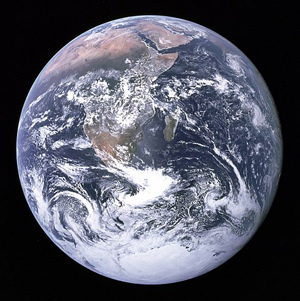
Maths in a minute: Escape velocity

Dying to get away?
When you jump up into the air you'll come back down to the Earth with a bump. That's not because the laws of nature categorically forbid you leaving the Earth, but because your jump isn't powerful enough to escape the Earth's gravitational field. To do that, the speed of your jump would have to exceed, or be equal to, the Earth's escape velocity which we can calculate quite easily as follows.
When you jump into the air your kinetic energy is $E_k=\frac{1}{2}mv^2,$ where $m$ is your mass and $v$ is your velocity. The potential energy you experience due to the Earth's gravitational pull is $E_p = \frac{GMm}{r},$ where $m$ is again your mass, $M$ is the mass of the Earth and $r$ is the Earth's radius. For you to be able to escape from Earth, we need $$E_k \geq E_p,$$ so $$\frac{1}{2}mv^2 \geq \frac{GMm}{r}.$$ Solving for velocity $v$ gives $$v \geq \sqrt{\frac{2GM}{r}}.$$ The Earth's escape velocity, $v_{Earth}$, is defined to be the smallest velocity that allows an object to escape, so $$v_{Earth}= \sqrt{\frac{2GM}{r}}.$$ Filling in the values $$G\approx 6.67 \times \frac{1}{10^{11}} \frac{m^3}{kg\;s},$$ $$M\approx 5.98 \times 10^{24} kg,$$ and $$r\approx 6.38 \times 10^6 m,$$ gives $$v_{Earth}\approx \sqrt{\frac{2\times 6.67 \times 5.98 \times 10^{24}}{ 6.38 \times 10^6 \times 10^{11} } \frac{m^3kg}{m\;kg\;s} .$$ Putting this into your calculator gives $$v_{Earth}\approx 11182 \frac{m}{s},$$ which translates to $40255.2km/h.$ You can use the same calculation to work out the escape velocity of any spherical body, as long as you know its mass and radius.Note that our formula for escape velocity is independent on the mass $m$ of the object that is trying to escape, as $m$ cancels out. So in theory you would need to achieve the same velocity to escape Earth as, say, an elephant. We should point out, however, that our calculation ignores the effect of air resistance which would effect you and the elephant differently. What is more, if you reached such a high velocity within the Earth's atmosphere, you would burn up. To avoid this, you or the elephant should first get yourself into an orbit in which the Earth's atmosphere is weak or non-existent, and then accelerate to the escape velocity needed to escape from that orbit. Find out more here.
Comments
Anonymous
11182 m/s is about 40255 km/h
Robert N
Could you check that 11182 m/s "translates" to 671 km/h ?? The units for G should be m˄3/kg s˄2
daCake
The gravitational constant should have units m^3/kg/s^2 not m^3/kg/s. This will asure that v_earth will have a unit of m/s. To transform this unit to km/h you have to multiply by 3.6. This gives us a speed of 40'255 km/h. I cant't figure out where the 671 km/h comes from.
Regards, daCake